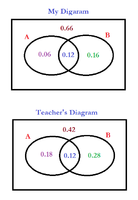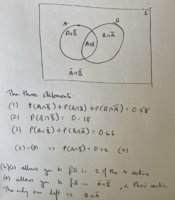A traveler is looking at upgrades received form airlines and rental car companies and found the following information:
- The probability that he receives either an airline upgrade or a rental car upgrade or both [MATH]= 58[/MATH]%.
- The probability that he receives only an airline upgrade [MATH]= 18[/MATH]%.
- The probability that he receives either an airline upgrade or a rental car upgrade but not both [MATH]= 46[/MATH]%.
Let [MATH]A[/MATH] be the event for airline upgrade and [MATH]B[/MATH] the event for rental car upgrade, and draw a Venn Diagram. Are the events receive a rental car upgrade and receive an airline upgrade independent? Explain/justify your answer.
This is what I did.
[MATH]P(A) + P(B) + P(AB) = 0.58[/MATH]
[MATH]P(A) = 0.18[/MATH]
[MATH]P(A) + P(B) = 0.46[/MATH]
Then,
[MATH]P(B) = 0.28[/MATH]
[MATH]P(AB) = 0.12[/MATH]
I have said that since [MATH]P(BA) \neq P(B) \cdot P(A)[/MATH], the events are not independent. I was shocked that the teacher marked it wrong!

Which diagram is correct? My diagram or the teacher's diagram. Can anyone help me please?
- The probability that he receives either an airline upgrade or a rental car upgrade or both [MATH]= 58[/MATH]%.
- The probability that he receives only an airline upgrade [MATH]= 18[/MATH]%.
- The probability that he receives either an airline upgrade or a rental car upgrade but not both [MATH]= 46[/MATH]%.
Let [MATH]A[/MATH] be the event for airline upgrade and [MATH]B[/MATH] the event for rental car upgrade, and draw a Venn Diagram. Are the events receive a rental car upgrade and receive an airline upgrade independent? Explain/justify your answer.
This is what I did.
[MATH]P(A) + P(B) + P(AB) = 0.58[/MATH]
[MATH]P(A) = 0.18[/MATH]
[MATH]P(A) + P(B) = 0.46[/MATH]
Then,
[MATH]P(B) = 0.28[/MATH]
[MATH]P(AB) = 0.12[/MATH]
I have said that since [MATH]P(BA) \neq P(B) \cdot P(A)[/MATH], the events are not independent. I was shocked that the teacher marked it wrong!

Which diagram is correct? My diagram or the teacher's diagram. Can anyone help me please?

